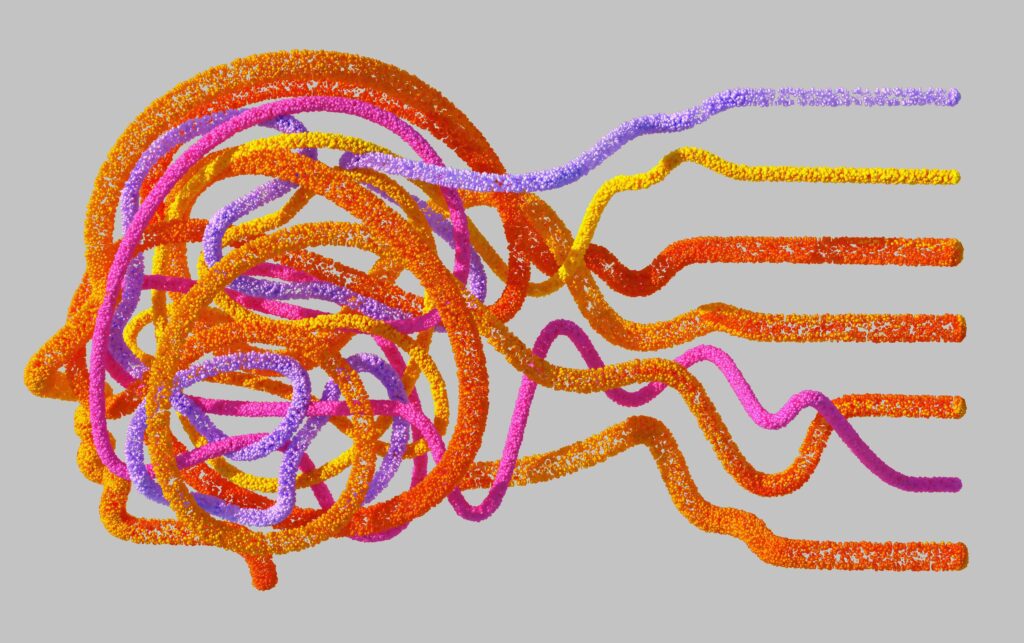Introduction:
The boundaries between humans and technology are rapidly dissolving. Among the most revolutionary developments is Brain-Computer Interface (BCI) technology, a system that enables direct communication between the human brain and external devices. When combined with the power of Artificial Intelligence (AI), BCIs are no longer just about moving a cursor on a screen — they are about restoring lost functions, enhancing human abilities, and even augmenting cognitive capacity.
Imagine a future where individuals with paralysis can control robotic limbs using only their thoughts, or where someone with a neurological disorder like ALS can communicate fluently through a digital assistant. Consider how surgeons could perform complex operations by seamlessly controlling surgical robots through their neural signals, or gamers could dive into fully immersive virtual worlds controlled entirely by their minds. This isn’t science fiction anymore — it’s happening right now, thanks to AI-enhanced BCIs.
The convergence of AI and BCI is transforming industries like healthcare, defense, gaming, education, and even marketing. As these technologies continue to advance, they are creating unprecedented career opportunities for engineers, researchers, healthcare professionals, and entrepreneurs.
Table of Contents
Imagine a world in which a person with paralysis could move a robotic arm simply through thought. Or a scenario where cognitive augmentation helps humans learn faster, focus deeper, or communicate telepathically. That’s not science fiction anymore — that’s the promise of Brain‑Computer Interfaces (BCIs) combined with Artificial Intelligence (AI).
If you’re drawn to the intersection of neuroscience, machine learning, hardware, ethics, and human experience — and you want to work on technologies that could transform lives — then a career in AI‑enhanced BCI might be one of the most impactful, exciting, and future-forward paths you could take.
However, it is also a highly interdisciplinary, technically challenging, and ethically sensitive domain. Success requires not just brilliance in one field but the ability to integrate across multiple domains — and to keep learning as the field evolves rapidly.
This guide will help you:
- Understand what BCI + AI means and why it’s compelling
- Map out the skills and knowledge you need
- Explore possible job roles and career trajectories
- Plan steps to build your portfolio and break into the space
- Anticipate challenges and pitfalls
- See where the future is headed and how you can contribute meaningfully
So let’s dive in.

2. What Are Brain‑Computer Interfaces?
A Brain-Computer Interface (BCI) is a system that establishes a direct communication pathway between the brain and an external device. This connection bypasses traditional pathways like muscles or speech. BCIs capture neural signals from the brain, process them, and translate them into commands that computers, prosthetic devices, or other systems can understand.
When AI algorithms are integrated into BCIs, the technology becomes far more powerful. AI helps in:
- Signal Processing: Filtering noise from brain signals (EEG, ECoG, or invasive electrodes) to extract meaningful patterns.
- Prediction: Using machine learning models to anticipate user intent.
- Personalization: Adapting to each user’s unique neural patterns for better accuracy.
- Real-Time Decision-Making: Enabling seamless control over complex systems like robotic limbs or virtual environments.
Key Components of AI-BCI Systems
- Signal Acquisition Devices: EEG headsets, implanted electrodes, or non-invasive sensors.
- Signal Processing Software: Algorithms to clean and interpret data.
- Machine Learning Models: Neural networks, deep learning, and reinforcement learning for pattern recognition.
- Output Device or Application: Robotic arms, wheelchairs, VR systems, gaming consoles, or medical devices.
- Feedback Mechanisms: Haptic feedback, auditory cues, or visual feedback to the user.
2.1 Overview & Taxonomy
At its core, a Brain‑Computer Interface (BCI) is a system that acquires signals from the brain, decodes the user’s intent, and translates those into control commands for external devices (e.g. computers, prosthetics, robots). Sometimes the interface is also bidirectional — meaning it can provide feedback (stimulation) or write information back to the brain.
BCIs are often categorized by:
| Dimension | Types / Categories | Typical Use / Examples |
|---|---|---|
| Invasiveness | Noninvasive (EEG, fNIRS, MEG, fMRI) Partially invasive (ECoG, intracortical arrays) Fully invasive (neural implants) | Noninvasive are safer, lower signal quality; invasive yield higher fidelity but with surgical risk |
| Signal modality | Electrical (EEG, ECoG, intracortical) Magnetic / electromagnetic Optical / fNIRS Chemical (neurotransmitter sensors) | Electrical is most common; new modalities are emerging |
| Unidirectional vs Bidirectional | Read-only (decode neural data) Read + Write (stimulation, neuromodulation) | Bidirectional offers closed‑loop systems for adaptive control |
| Application domain | Assistive / Rehabilitation Augmentation / Enhancement VR / AR / Gaming Research / Diagnostics | Each domain has its own constraints and demands |
The goal of an AI-enhanced BCI system is to leverage machine learning / AI to better decode (and potentially encode) neural signals, improving robustness, adaptivity, personalization, and usability.
A recent classification called Brain-Artificial Intelligence Interfaces (BAI) proposes that instead of building raw BCIs, we build systems where the brain gives intent and the AI fills in the low-level details — effectively bypassing part of the cognitive pipeline via AI.
2.2 Why AI Matters in BCI
Without AI, BCI systems rely on handcrafted signal processing pipelines: filtering, feature extraction, pattern recognition. These systems often struggle with inter-subject variability, noise, non‑stationarities (signals drift), low signal-to-noise ratio, and limited generalization.
AI (especially deep learning, reinforcement learning, transfer learning, hybrid models) brings the ability to:
- Adapt models continuously (online learning)
- Generalize across subjects, sessions, tasks
- Combine multimodal signals (e.g. EEG + EMG + eye tracking)
- Perform generative modeling (e.g. infer missing signals)
- Predict user intent robustly even under noise
- Close the loop in real time with adaptive stimulation, error correction
For instance, a very recent work surveys how EEG signals are being bridged with generative AI (text, image, speech) using transformer, diffusion, GAN models, improving the expressiveness of BCI outputs.
Similarly, in rehabilitation, AI-enhanced BCIs have shown promise in more robust control and adaptation for patients recovering motor function.
Because of these advantages, AI-enhanced BCI is increasingly seen as the future direction of the field — and a ripe area for cutting-edge careers.
2.3 Recent Advances / Use Cases
Here are a few standout examples and trends:
- Synchron + NVIDIA: Synchron’s BCI system now integrates with NVIDIA AI and Apple Vision Pro to let participants with paralysis control home devices using thought.
- Noninvasive bidirectional BCI via ultrasound: Researchers integrated focused ultrasound stimulation with EEG, enabling bidirectional interfaces and improved performance.
- Neuralink & human trials: Neuralink has enabled participants to control cursors or write using neural implants.
- OpenBCI (open‑source hardware): A community-driven platform that supports EEG, EMG, EKG and integrates with open-source software tools.
- Conversational BAI: A research prototype that uses AI with noninvasive EEG to enable fluid communication based on high-level intent without explicit language generation.
- Hybrid brain + AI / spiking networks: The fusion of neuromorphic AI and BCIs is an emerging theme, aiming for tight integration and low-power systems.
These innovations show how fast the field is evolving — and how many open problems still remain.
3. The Landscape: Opportunities, Challenges & Trends
3.1 Application Domains & Markets
Below are key domains where AI‑enhanced BCIs can (and are) making impact:
| Domain | Demand / Market | Potential Roles / Revenue Streams |
|---|---|---|
| Medical & Healthcare | BCI for paralysis, stroke rehabilitation, neuroprosthetics, sensory substitution | Medical devices firms, clinical trials, regulatory, hospital deployment |
| Assistive Technology | Communication aids for ALS, locked-in syndrome, accessibility tools | Nonprofits, startups, licensing / assistive tool providers |
| Augmentation / Cognitive Enhancement | Focus, memory, mood, attention boosting (for healthy users) | Consumer devices, wearables, neurotech startups |
| Gaming / VR / AR / Entertainment | Mind-controlled games, immersive experiences | Game studios, XR hardware, entertainment firms |
| Education & Training | Neurofeedback, adaptive learning, attention monitoring | Edtech firms, research labs |
| Brain-Machine / Brain-to-Brain | Multi-user interaction, shared cognition | Experimental systems, defense / research institutes |
| Research, Neuroscience & Diagnostics | Brain mapping, neuroimaging, brain health analytics | Academia, neurotech consortia, research labs |
| Security & Authentication | Brainwave-based biometrics or authentication | Security startups, identity firms |
Because of the wide scope, AI-enhanced BCIs sit at an interdisciplinary junction — opening many paths for specialization.
3.2 Technical Challenges
To build robust, deployable AI-BCI systems, you’ll face challenges like:
- Low Signal-to-Noise Ratio: Neural signals (especially noninvasive) are weak and contaminated by noise (muscle, electromagnetic, electrode artifacts).
- Nonstationarity / Drift: Brain signals change over time, between sessions, due to fatigue, electrode shifts.
- Inter-Subject Variability: Each person’s brain is different, making model generalization hard.
- Latency & Real-Time Constraints: Closed-loop systems require inference in real time with minimal lag.
- Data Scarcity & Labeling: Collecting high-quality labeled neural data is expensive, time-consuming, and often subject to regulatory constraints.
- Hardware Constraints: Embedded devices must handle power, size, safety, signal conditioning, wireless, robustness.
- Adaptive / Online Learning & Continual Learning: Models must adapt without catastrophic forgetting.
- Integration & Multimodality: Integrating EEG, fNIRS, EMG, eye tracking, IMUs, context data.
- Feedback / Stimulation Safety: In bidirectional systems, stimulating brain circuits safely is nontrivial.
- Regulation & Certification: Medical-grade standards (CE, FDA), safety, validation, reproducibility.
- Ethical & Security Risks: Privacy, autonomy, mind hacking, unintended modulation, consent.
Part of your career will be navigating (and hopefully solving) these challenges.
3.3 Ethical, Legal & Social Issues
BCI is powerful — and potentially perilous if misused. Some key ethical and social dimensions include:
- Cognitive Liberty & Consent: Users must retain autonomy. The system should never “read thoughts” without permission or operate beyond intended scope.
- Privacy & Data Security: Neural data is extremely personal; strict safeguards, encryption, anonymization are mandatory.
- Bias & Equity: Models trained on limited populations may not generalize across demographics.
- Liability & Safety: If a BCI misinterprets a command (e.g. in prosthetics), who is liable?
- Regulation & Oversight: Government and health authorities may require stringent approvals, especially in medical contexts.
- Psychological & Identity Effects: Users may feel alienated if systems ‘intervene’ in their mind.
- Dual-Use Concerns: Military or surveillance applications (neural coercion).
- Long-term Effects: Safety of long-term implants, stimulation, tissue reaction.
You’ll likely engage with ethicists, regulatory bodies, and policymakers in many roles.

3.4 Future Trends
Here are some of the key directions shaping the horizon:
- Hybrid AI / Neuromorphic Systems: Combining spiking neural networks, event-driven architectures, and standard deep learning for efficient BCI processing.
- Generative Models for Neural Decoding: Using diffusion models, GANs, transformers to decode or simulate brain signals (e.g. EEG-to-image or EEG-to-text)
- Brain-Artificial Intelligence Interfaces (BAI): Systems that accept high-level intent and let AI fill in details.
- Noninvasive / Minimally Invasive Methods: Techniques using ultrasound, transcranial magnetic stimulation, and new sensors to reduce or avoid surgery.
- Inter-brain / Multi-user BCIs: Shared cognition, brain-to-brain communication, collaborative thought systems.
- Closed-loop Adaptive Systems: Systems that monitor and modulate brain states in real time (feedback loops).
- Cognitive Augmentation & Wellness: Focus, memory, mood regulation for healthy users rather than pathology.
- Brain Foundation Models: Large neural datasets used to build general-purpose models of brain activity (analogue of large language / vision models).
- Commercial & Consumer BCIs: As the technology matures, consumer-grade BCIs (wearables, headsets) become mainstream.
If you aim for the future, positioning yourself at the intersection of AI, neuromorphic architectures, and applied neuroscience is advantageous.
4. Skills, Disciplines & Knowledge You Need
A career in AI-enhanced BCI demands mastery across multiple domains. Below is a breakdown of the key areas you should develop.
4.1 Core Technical Foundations
Before diving deep, you must build a strong base:
- Mathematics: Linear algebra, calculus, probability, statistics, optimization
- Signal Processing: Filtering, Fourier transforms, wavelets, time-frequency analysis
- Programming & Software Engineering: Python, C/C++, MATLAB; clean code, version control, debugging skills
- Algorithms & Data Structures: Core computational thinking, algorithmic complexity
- Systems / Embedded Programming: Real-time systems, microcontrollers, firmware, GPIO, interrupts
- Digital / Analog Electronics: Sensors, amplifiers, ADCs, signal conditioning, noise reduction
These foundations are prerequisites for any specialized BCI work.
4.2 AI / Machine Learning in BCI
This is the heart of “AI‑enhanced” BCI:
- Supervised Learning: Classification, regression, model selection, evaluation
- Deep Learning: CNNs, RNNs, Transformer models, autoencoders
- Time Series Modeling: LSTM, GRU, temporal convolution, attention, hybrid models
- Transfer Learning / Domain Adaptation: Generalizing models across subjects, sessions
- Online / Incremental Learning: Updating models in real time, avoiding catastrophic forgetting
- Reinforcement Learning: Adaptive control, feedback, trial & error learning
- Generative Models: GANs, diffusion models for signal synthesis / augmentation
- Multimodal / Fusion Models: Combining EEG + EMG + IMU + context data
- Explainable AI / Interpretability: Why did the model predict this intent?
- Model Compression / Pruning / Efficient Inference: For real-time and embedded use
Because data is expensive in BCI, clever use of transfer learning, few-shot learning, self-supervised methods are especially valuable.
4.3 Neuroscience, Signal Processing & Neurophysiology
Understanding the brain is central:
- Neuroanatomy & Brain Regions: Motor cortex, sensory cortex, visual, prefrontal areas
- Neurophysiology: Action potentials, synapses, local field potentials
- Electrophysiology: EEG, ECoG, intracortical, electrode design
- Brain Rhythms & Oscillations: Theta, alpha, beta, gamma bands; event-related potentials (ERP)
- Artifact / Noise Sources: Eye blinks, muscle artifacts, line noise
- Neuroplasticity & Learning: How the brain changes with adaptation
- Neurosensory Stimulation: TMS, tDCS, ultrasound, optogenetics (in research)
- Cognitive Neuroscience / Psychology: Attention, perception, working memory, neural coding
This domain knowledge helps you interpret signals well and design better AI models.

4.4 Hardware, Embedded Systems & Interfaces
Your AI models must connect to physical sensors and devices:
- Analog Front-End (AFE): Preamplifier design, filters, shielding, noise suppression
- Analog-to-Digital Conversion (ADC) & Sampling Theory
- FPGA / ASIC / SoC Design: For high-speed processing or hardware acceleration
- Wireless / Communications: Bluetooth, Wi-Fi, custom RF, low-power protocols
- Power & Energy Efficiency: Battery life, power management
- Safety & Signal Isolation: Especially for medical / implanted systems
- Miniaturization & Packaging: Designing for wearables, implants
- Sensor Modalities & Interfaces: EEG caps, electrode arrays, hybrid sensors
Strong hardware skills make your AI models feasible in real-world prototypes.
4.5 Human Factors, UX, Cognitive Science
BCIs are systems that users must interact with, so you also need:
- UX / HCI Design: How users perceive and control the system
- Latency & Feedback Design: Ensuring real-time responsiveness
- Adaptivity & Calibration: Minimizing user burden in calibration
- User Testing & Evaluation: Usability, fatigue, performance metrics
- Cognitive Load, Attention & Fatigue: Accounting for human limitations
- Accessibility & Inclusion: Ensuring the system works for diverse users
- Ethics & Informed Consent: Designing consent flows, privacy controls
These “softer” skills are critical to building systems people actually use.
4.6 Ethics, Security, Privacy & Policy
Given the sensitivity of neural data, you’ll also need competence in:
- Data Privacy / Encryption / Secure Storage
- Adversarial Robustness: How to defend against neural signal spoofing
- Regulations & Standards: Medical device regulation (FDA, CE), data protection (GDPR)
- Safety & Risk Assessment
- Ethical Frameworks: Consent, cognitive liberty, bias
- Intellectual Property / Patents
- Societal Impact & Public Perception
As your career advances, you’ll often act as a bridge between technical and regulatory / policy stakeholders.
5. Educational Pathways & Certifications
There is no single “AI-BCI degree,” so you’ll build a portfolio of complementary credentials.
5.1 Academic Degrees (Undergrad, Masters, PhD)
A typical strong academic base might look like:
- Undergraduate degree: Electrical Engineering, Biomedical Engineering, Computer Science, Neuroscience, Physics, or related field
- Master’s / Specialized MSc / MS: Concentration in neural engineering, brain–machine interfaces, computational neuroscience
- PhD: Deep research in BCI, neural decoding, brain‑AI interface systems
During these degrees, aim for interdisciplinary research projects combining neuroscience, signal processing, and machine learning.
5.2 Specialized Programs & Bootcamps
Some institutions or organizations may offer short-term specialization in neurotechnology, BCI, neuroengineering. This might include:
- Workshops or summer schools in neural engineering
- Bootcamps combining neuroscience + AI
- Collaborative summer internships at neurotech labs
- Online micro-masters or certificate programs (e.g. Coursera, edX)
These help fill gaps between your core degree and the niche of BCI.
5.3 Internships, Research Labs & Open Source Projects
Hands-on experience is critical:
- Internships in neurotech companies or labs
- Research assistant positions in neuroscience / BCI labs
- Open source BCI projects: e.g. OpenBCI, EEG processing toolkits
- Hackathons / challenge competitions: EEG decoding, brainwave classification contests
These also help you build real demonstrations and network connections.
5.4 Certifications, Workshops & Online Learning
To round off your credentials:
- Machine learning certifications (e.g. Coursera, DeepLearning.ai)
- Signal processing / DSP courses (EdX, MIT OpenCourseWare)
- Medical device / regulatory course
- Ethics / data privacy certifications
- Workshops in ML, neurotech conferences
Additionally, contributing to workshops or giving tutorials helps your visibility.
6. Possible Career Roles & Job Titles
Here’s a deeper look at roles you might fill in the AI‑BCI ecosystem.
6.1 Research Scientist / Neural Engineer
- Conduct original research in neural decoding, adaptive learning, closed-loop BCI
- Publish papers, lead experiments, obtain funding
- Role often in academia, corporate R&D labs, or national institutes
6.2 Algorithm / AI Engineer (Neural Decoding)
- Build, train, and optimize ML / AI models to translate brain signals into actions
- Optimize latency, robustness, adaptation
- Work closely with signal processing and hardware teams
6.3 Hardware / Embedded Systems Engineer
- Design sensor front-ends, electrode electronics, embedded systems
- Work on real-time pipelines, custom chip design, low-power systems
6.4 Signal Processing Engineer
- Clean, filter, preprocess neural data
- Feature engineering, artifact removal
- Interface between raw brain signals and AI models
6.5 Clinical / Translational Engineer
- Deploy BCI systems in hospitals / clinical trials
- Bridge engineering with medical protocols, ethics, patient interaction
- Validate, calibrate, monitor systems in real-world conditions
6.6 Product / UX / Human Factors Specialist
- Design interfaces, calibration protocols, user flows
- Focus on real-world usability, fatigue, feedback
- Work in consumer neurotech, assistive devices, BCI software
6.7 Entrepreneur / Startup Founder
- Build new neurotech products, devices, platforms
- Raise capital, manage teams, find product-market fit
- Wear multiple hats (technical, business, regulatory)
6.8 Policy, Ethics & Regulatory Expert
- Work on safety, standards, regulatory filings, ethics committees
- Translate public policy into technical constraints
- Advise companies, governments, NGOs
Often, individuals play hybrid roles, especially in startups (e.g. algorithm + product + regulatory).
7. Sample Career Pathways & Roadmaps
Below is a sample comparative table summarizing trade‑offs between possible paths:
| Path | Key Strengths / Pros | Challenges / Cons | Ideal For |
|---|---|---|---|
| Academic / Research | Freedom to pursue novel ideas, publish, high prestige | Grant pressure, slower commercialization | Deep thinkers, innovators |
| Corporate R&D / Big Tech | Good resources, scale, stability, cross-disciplinary teams | Less autonomy, product timelines | Forerunners who want impact at scale |
| Startup / Commercial | Fast-paced, potential high reward, ownership | High risk, multi-discipline demands | Entrepreneurs, jack-of-all-trades |
| Clinical / Translational | Real-world impact, regulatory exposure | Slow approvals, clinical constraints | Those who love applied healthcare |
| Policy / Ethics / Regulation | Shaping system-level influence, overseeing safety | Less hands-on engineering | Ethically minded, cross-disciplinary |
Roadmap Example: Entry → Mid → Senior
- Entry (0–2 years)
- Internship or research assistantship
- Build small BCI projects (e.g. EEG decoding)
- Publish or open-source a demo
- Mid (3–7 years)
- Working full-time in neurotech / lab
- Lead module or project (e.g. adaptive decoder)
- Publish in top conferences, get patents
- Begin collaborating with clinical / product teams
- Senior (7+ years)
- Lead R&D group or lab
- Propose new architectures (e.g. generative decoding)
- Found or lead a startup / spin-off
- Mentor junior researchers, interface with regulation
Switching from Adjacent Domains
Many people may come from ML, robotics, embedded systems, neuroscience, or signal processing backgrounds. To switch:
- Start with a bridge project (e.g. use EEG + ML in your domain)
- Publish or demonstrate crossover work
- Join BCI / neurotech labs part-time or via open source
- Fill gaps (neuroscience, ethics) via coursework or bootcamps
Entrepreneurial / Spin-Off Path
If you aim to build a startup:
- Start small with a demo or MVP (e.g. brain-controlled game or assistive tool)
- Validate market need early
- Secure seed funding or grants (e.g. NIH, SBIR, EU, national grants)
- Build a core team (ML, neuro, hardware, regulatory)
- Iterate with early users / pilots
- Pursue compliance, clinical trials, certifications
Academia & Research Route
- During your PhD, aim to publish in strong journals
- Network with neurotech consortia
- Seek post-doctoral positions in BCI labs
- Apply for independent funding (e.g. research fellowships)
- Eventually establish your own lab or join leading institutions
8. Building a Portfolio & Personal Brand
You’ll need to stand out. Here’s how:
8.1 Projects & Demonstrations
- Prototype a simple BCI system: e.g. use a cheap EEG headset to decode visual evoked potentials
- Open-source tools / libraries: contribute to BCI toolkits, EEG processing packages
- Capstone / Thesis works: design something that blends AI + neuroscience
- Competitions / challenges: BCI hacking contests, Kaggle-style neuro datasets
- Collaborative projects: with neuro labs, medical groups, rehab centers
8.2 Publication, Patents & Conferences
- Publish in flagship conferences: NeurIPS, ICML, ICLR, IEEE EMBC, NIPS, Journal of Neural Engineering, etc
- Submit short demos / posters in neurotech / BCI conferences
- If novel, consider patents (especially if startup route)
8.3 Open Source Contributions
- Contribute to or launch BCI repos (e.g. preprocessing, decoders)
- Provide tutorials, sample datasets
- This visibility helps attract collaborators
8.4 Communities, Conferences, Networks
- Join BCI Society, IEEE Neural Engineering, neurotech meetups
- Participate in workshops, summer schools
- Network with labs, clinicians, startups
8.5 Online Presence, Blogging & Social Media
- Maintain a blog or website showcasing your BCI/AI projects
- Publish breakdowns, tutorials, demo videos
- Share code on GitHub
- Use LinkedIn / Twitter to disseminate insights
- Occasionally speak at webinars or local meetups
A strong portfolio + reputation helps open doors.
9. Tips to Land Jobs / Funding / Grants
9.1 Resume & Interview Tips
- Focus on impact: what your project did, how performance improved
- Show cross-disciplinary fluency: AI + neuroscience + hardware
- Include demo videos / links / code
- For interviews: be ready to explain neural signal processing, your model choices, latency tradeoffs, design decisions
- Expect domain bridging questions (how does EEG artifact removal work? how to adapt a model across subjects?)
9.2 Grant / Fellowship Applications
- Seek national / international funding (e.g. NIH, EU, national science agencies)
- Align your proposal with high-impact domains (healthcare, assistive tech)
- Build partnerships with hospitals, clinics, clinicians
- Show preliminary results or simulations
9.3 Collaborations & Multi‑disciplinary Teams
- Work with neuroscientists, clinicians, ethicists, hardware specialists
- Be a “translator” between domains
- Engage in consortiums or multi-institution grants
9.4 Raising Capital as a Startup
- Early-stage grants, seed funding, government innovation funds
- Show prototype, validation, user feedback
- Be mindful of the regulatory / clinical path
- Hire or associate regulatory / clinical advisors

10. Challenges & Pitfalls — and How to Overcome Them
10.1 Technical Bottlenecks
- Overfitting / poor generalization: use cross-subject or cross-session validation
- Latency issues: optimize inference, pruning, model compression
- Artifact contamination: carry out robust denoising, adaptive filtering
- Hardware noise & drift: include calibration, redundancy, adaptive algorithms
- Limited data: leverage data augmentation, transfer learning, synthetic data
10.2 Interdisciplinary Gaps
- Engineers often lack neuro understanding; neuroscientists often lack deep ML skills
- Bridge the gap by self-learning, collaborating, enrolling in short courses
- Cultivate humility and willingness to learn across domains
10.3 Ethical / Societal Pushback
- Be proactive: include ethicists from early stage
- Prioritize user safety, privacy, informed consent
- Educate stakeholders (communities, users, regulators)
10.4 Funding & Commercialization Hurdles
- Investors may be risk-averse in medical devices
- Clinical validation is cost- and time-intensive
- Mitigation: start with lower-risk assistive or consumer applications, de-risk early
10.5 Staying Updated & Avoiding Obsolescence
- The AI and neuro field changes rapidly
- Follow top conferences, journals, new models, datasets
- Dedicate time periodically for learning and experimentation
11. Vision & Impact — What You Could Help Create
Here’s what you might build or contribute to in your career:
- Restoring Function for Disabled Individuals
- Thought-controlled prosthetics, exoskeletons, speech prostheses
- Enabling full environmental control (smart homes, communication)
- Augmented Cognition
- Real-time memory or attention support, brain-based tutoring, workload balancing
- Brain-to-Brain / Collaborative BCIs
- Shared mental models, synchronized group decisions
- Human‑AI Hybrid Systems
- AI agents that integrate with your brain intent, acting as partners
- New Paradigms in Education, Creativity, Entertainment
- Neurointerfaces for immersive gaming, artistic expression, learning
- Brain Health & Diagnostics
- Early detection of neurological disease, brain monitoring
- Ethical, Inclusive Neurotech
- Ensuring equitable access, privacy-first designs, governance
The potential is enormous — and you can steer it toward good for humanity.
12. Summary & Action Plan
If you want to build a career in AI‑enhanced BCI, here’s a suggested 12‑month action plan:
| Months | Goals / Tasks |
|---|---|
| 0–3 | Choose a foundational focus (neuroscience, AI, hardware) Start a small BCI project (e.g. use free EEG device) Enroll in ML + signal processing courses |
| 3–6 | Refine your project, add AI models, publish results Apply for internships / RA positions Engage with BCI / neurotech communities |
| 6–9 | Expand project complexity (multimodal, adaptation) Contribute to open-source BCI tools Prepare application materials (resume, portfolio) |
| 9–12 | Apply to positions, labs, startups Submit proposals / small grants Present your work (online, workshops) |
Conclusion: Building the Future with AI and BCI
A career in AI-enhanced Brain-Computer Interfaces is more than just a job — it’s an opportunity to reshape the way humans interact with technology. Whether you’re helping a paralyzed patient regain mobility or designing next-gen gaming experiences, you are contributing to one of the most transformative fields of our time.
The key is to start now: learn the basics, gain hands-on experience, and network with professionals. As AI and neuroscience continue to advance, those who position themselves today will become the pioneers of tomorrow’s human-machine symbiosis.
follow us on whatsapp channel

















